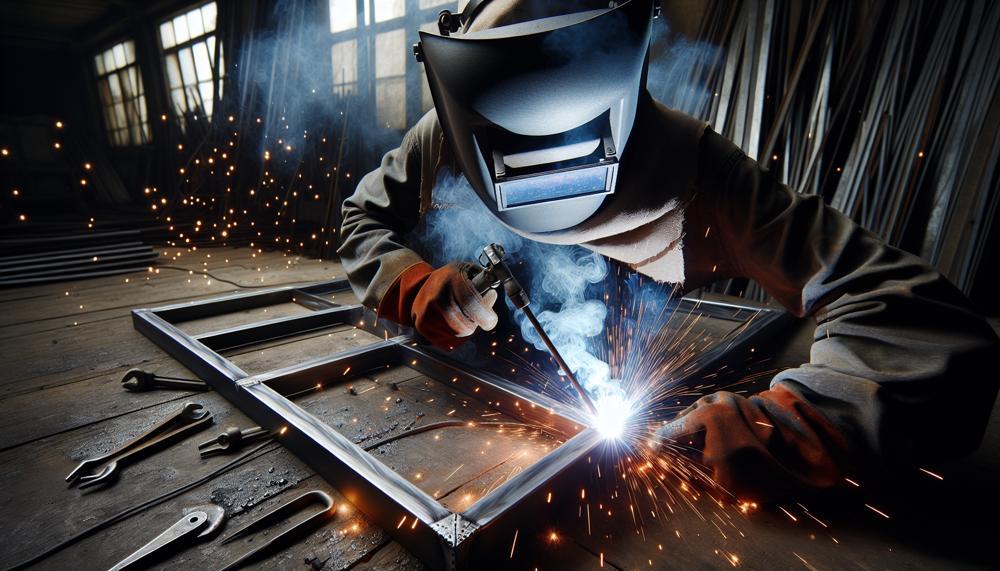Are you eager to construct a unique frame for your latest project or repair an existing one? Before you dive into the welding process, it’s crucial to understand the safety measures that come with this task. Welding may seem straightforward, but it involves working with high temperatures and potentially hazardous materials. Don’t worry, we’ve got you covered with these essential points to keep in mind:
- Welding requires extreme heat – always wear protective gear such as gloves, goggles, and a welding helmet.
- Proper ventilation is key – ensure there is adequate air flow in your workspace to avoid inhaling harmful fumes.
- Be mindful of flammable materials – remove any nearby objects or substances that could easily catch fire.
- Take breaks – don’t push yourself too hard and take frequent breaks to prevent fatigue and maintain focus.
- Clean up after yourself – sparks can easily ignite debris, so make sure to tidy up any scraps or materials before starting.
By following these safety tips, you can confidently weld your frame without jeopardizing your well-being or others’.
Now let’s get started.
Contents
Frame Welding Methods
Frame welding methods are essential to creating a strong and durable frame. These methods include GMAW, GTAW, SMAW, and FCAW. Out of these options, GMAW is the most recommended for ensuring a sturdy and long-lasting frame. This is due to its precise control, ability to produce clean and smooth welds, and versatility in welding various metals and thicknesses.
In fact, GMAW has become increasingly popular among beginners due to advancements in equipment and technology that make it easier to use.
However, it’s crucial to take necessary safety precautions when using any welding method. This includes having proper knowledge and skills in welding to ensure a safe and strong weld for the frame. As with any skill, practice makes perfect.
By continuously improving your welding techniques and staying up-to-date with advancements in equipment, you can create high-quality frames that stand the test of time.
Problems With Frames
When working with frames, it’s essential to be aware of potential issues that may arise during the welding process. These problems can stem from incorrect welding techniques, poor quality materials, or inadequate surface preparation. To prevent these defects, it’s crucial to follow proper welding procedures and techniques, use high-quality materials, and regularly inspect welds for any imperfections.
Another common issue is distortion in frames due to uneven heating and cooling during the welding process. To avoid this problem, careful planning and preparation are necessary. Consider the type and thickness of the metal being welded and use preheat techniques to control heat input.
Additionally, there are potential hazards of fire and explosions when working with frames. This can be caused by the presence of flammable materials, sparks or hot fragments, and inadequate ventilation.
To prevent accidents, it’s important to identify potential risks before welding, remove any flammable materials from the area, ensure proper ventilation, have a fire extinguisher nearby, and wear appropriate personal protective equipment.
By being aware of these potential problems and taking the necessary preventative measures, you can ensure a successful and safe welding experience.
| Problems With Frames | Possible Causes | Prevention/Fix |
| Welding Defects | Inadequate welding techniques, substandard materials, improper surface preparation | To avoid welding defects, follow appropriate welding procedures and methods, utilize high-quality materials, regularly inspect welds for imperfections. |
| Distorted Frames | Uneven heating and cooling during welding process | Effective planning and preparation are crucial. Take into account the type and thickness of the metal. Use preheat techniques and control heat input to reduce distortion. |
| Hazards of Fire and Explosions | Risk of flammable substances, sparks or hot fragments, inadequate ventilation | Prior to welding, identify potential hazards. Remove flammable materials from the area. Ensure proper ventilation and have a fire extinguisher nearby. Wear appropriate personal protective equipment. |
Bending
Welding frames requires careful consideration of bending to ensure safety. Bending can put stress on welded joints, causing potential cracks and failures. Therefore, it is essential to handle and transport frames properly to prevent any bending that could jeopardize their safety during the welding process.
Additionally, it’s important to note that the type of welding used can also affect bending. For example, MIG welding, which is a popular choice for beginners, may result in less bending due to its smoother process. On the other hand, stick welding, commonly used by professionals, offers more versatility but also has a higher risk of bending due to its more intense application.
Furthermore, it’s crucial to inspect frames for any signs of bending before and after the welding process. This can be done by using specialized tools or simply checking for visible deformities.
If any bending is detected, it’s important to address it before proceeding with the welding to prevent compromising the frame’s structural integrity.
Cracks
Welded frames are prone to developing cracks, which can result from various factors such as incorrect welding techniques, impurities in materials, extreme temperatures, and inadequate design or support.
A simple mistake in the welding technique can lead to cracks in the frame, compromising its structural integrity.
Therefore, it is essential to follow proper welding procedures, which involve carefully controlling the temperature and using the correct welding techniques for the specific materials being used.
Another common cause of cracks in welded frames is the presence of impurities in materials. These impurities can create weak spots in the frame, making it more susceptible to cracking. To avoid this issue, it is crucial to thoroughly clean and prepare materials before welding. This not only removes any impurities but also ensures a smooth surface for a stronger weld.
Extreme temperatures can also play a significant role in causing cracks in welded frames. Welding at excessively high or low temperatures can cause the metal to weaken and become brittle, increasing the chances of cracks forming. Therefore, it is vital to maintain a moderate temperature range during welding to prevent this from happening.
In addition to proper welding techniques and material preparation, having adequate support during welding is crucial in preventing cracks. Without proper support, the frame may warp or bend during the welding process, leading to stress points that can result in cracks. To avoid this, it is essential to use appropriate support structures and fixtures when welding.
Regular inspections and maintenance are also crucial in identifying and preventing cracks in welded frames. By conducting routine checks, any potential issues can be detected early on and addressed before they become significant problems.
Frame Welding Legal Issues
| Legal Compliance | It is crucial to adhere to local, state, and federal regulations, such as those set by OSHA, to ensure safety standards are met. |
| Licenses and Certifications | For certain types of welding or specific locations, it may be necessary to obtain relevant licenses and certifications. |
| Insurance Protection | Having liability insurance is essential for protecting both the welder and the client in case of any accidents or damages. |
| Written Agreement | A written contract outlining details such as scope of work, deadlines, payment terms, and liability responsibilities should be established with the client. |
Apart from these legal considerations, welders must also be knowledgeable about potential environmental concerns or restrictions that may arise when working on a frame. This may involve proper disposal of hazardous materials used in the welding process or adhering to emission standards set by environmental agencies.
Another important aspect to consider is the source of materials used in the welding process. It is crucial to obtain materials from reputable sources and avoid using counterfeit materials that can not only compromise the quality of work but also result in legal consequences.
Furthermore, welders should also be mindful of copyright and intellectual property laws when creating a frame. This is particularly relevant for custom-made frames where the design may be unique or copyrighted by someone else.
Frame Welding Procedure
When preparing to weld a frame, it is crucial to take the necessary precautions and follow safety protocols. To ensure a safe and successful weld, here are the essential steps that should be followed:
- Thoroughly clean and prepare the surfaces: It is important to properly clean and prepare the surfaces before welding. Removing any paint, rust, or contaminants will promote proper adhesion and prevent potential hazards.
- Use jigs or fixtures for alignment: To maintain accuracy and alignment, it is recommended to use jigs or fixtures when welding a frame. This will help prevent distortion and ensure a precise fit.
- Select the appropriate welding process: There are various welding processes that can be used for frame welding, such as MIG or TIG. It is essential to choose the most suitable process for your specific project and ensure proper penetration, heat control, and travel speed.
- Use angled cuts instead of straight cuts: When cutting parts for a frame, it is best to avoid straight cuts. Instead, cut the sides and top/bottom flanges at a 45 degree angle. This helps disperse stress loads and allows for a greater amount of weld surface area.
- Reinforce as necessary: Depending on the type of frame being welded, it may require reinforcement for added strength. This can be achieved by loading the frame inside with tubing that fits within the current frame or by welding on “fish plating” or load-dispersing panels on the outside.
- Always prioritize safety: Welding can be dangerous, so it is crucial to follow safety protocols and guidelines set by the manufacturer. Wear appropriate protective gear, keep a fire extinguisher nearby, and ensure proper ventilation in the work area.
By following these essential steps, welders can safely produce high-quality frames that are structurally sound and meet all necessary guidelines and regulations.
Truck Frame Welding
To guarantee safe truck frame welding, strict adherence to safety standards is crucial. These standards are set by governing bodies such as the Department of Transportation (DOT) and must be followed at all times.
This includes thorough preparation, ensuring appropriate safety gear is used, and creating an optimal work environment. Additionally, it is essential to have certified professionals handle any repairs or modifications on your truck frame in accordance with state regulations.
Before making any changes or repairs to a truck frame, it is important to seek approval from licensed mechanics or engineers. They can provide valuable insight into weight distribution and the structural integrity of the frame and ensure that any modifications comply with state laws and regulations.
When it comes to welding techniques, it is vital to consider their impact on the strength of a truck frame. While methods such as MIG (Metal Inert Gas) welding may be popular, they can actually weaken the frame more than other methods. This highlights the importance of proper training and experience in achieving successful welds that prioritize the safety of both the driver and passengers.
Remember, welding a truck frame is not a task to be taken lightly. It is a complex process that requires attention to detail and adherence to safety standards.
Bike Frame Welding
Bike frames are crafted from a variety of materials such as steel, aluminum, carbon fiber, and titanium, each requiring specific welding techniques for optimal strength and durability.
To safely weld a bike frame, it is essential to follow these best practices:
- Thorough preparation: Before beginning the welding process, it is crucial to clean the frame and materials, removing any contaminants that could impact the quality of the weld. This includes eliminating rust or paint from the frame.
- Certified professionals: Welding is a specialized skill that requires proper training and experience. Therefore, it is vital to have a certified professional handle the job, ensuring the frame is welded correctly and safely.
- Weight distribution: Proper weight distribution is key when welding a bike frame to withstand the pressure and stress it will face while in use. This involves evenly distributing weight along the frame and avoiding any weak spots.
- Selecting the right welding technique: TIG welding offers precision and control when working with thin-walled frames made of aluminum and titanium. However, MIG welding is faster and commonly used for steel frames due to its ability to handle thicker materials.
- Utilizing specialized equipment and jigs: Precise alignment is crucial during the welding process, so using specialized equipment and jigs can ensure accurate placement of tubes before welding.
- Automated methods: While manual welding is still common, automated methods like robotic welding offer superior precision and consistency in the welding process. However, these methods come at a higher cost.
- Careful design: The design stage sets the foundation for the rest of the welding process, making careful consideration of fit and feel parameters necessary. This includes selecting suitable materials and cutting them with precision.
- Fixtures for proper alignment: To ensure proper alignment of the frame, using fixtures to hold pieces in place during welding is essential.
- Adding braze-ons and finishing touches: Personalize the frame by adding braze-ons while also giving it a polished finish with cleaning and painting to protect against rust and corrosion.
Technicalities of Frame Welding
When it comes to frame welding, the type of welding process used can greatly impact the quality and safety of the weld. The most common methods include GMAW, SMAW, TIG, or Oxy-Fuel Welding.
However, it is important to note that each process has its own set of technicalities that must be carefully considered before starting the welding process.

For instance, GMAW is the most popular method for welding frames due to its efficiency and effectiveness. However, it also produces harmful fumes that require proper ventilation and safety precautions. It is crucial to take these precautions seriously to ensure a safe and successful weld.
Another important factor to consider is the type and condition of the metal being welded. Mild steel, stainless steel, aluminum, and other metals all require different techniques and preparations for welding. Proper identification and preparation of the metal are crucial to ensure a strong and safe weld.
Proper joint preparation is also essential for creating strong welds in frames. This includes removing any rust or contaminants and ensuring the edges are properly beveled for full penetration welds. Neglecting this step can result in weak and unsafe welds.
The welding technique used plays a critical role in creating safe and structurally sound frames. Fillet welding is commonly used for frames due to its versatility and strength. However, it is important to maintain proper heat control and filler metal deposition to prevent distortion and ensure proper penetration.
In addition to these key technical aspects, it is important to consider factors such as joint design, heat distribution, and filler material selection when welding a frame.
Conclusion
In conclusion, welding a frame may appear to be a straightforward task, but it involves working with high temperatures and potentially hazardous materials. Therefore, prioritizing safety is crucial.
This means equipping yourself with protective gear, ensuring proper ventilation, removing flammable materials from the work area, taking breaks to avoid fatigue, and cleaning up after yourself. For beginners, GMAW is the recommended method due to its precision and versatility.
However, it’s important to be aware of potential problems that may arise during the welding process. These include welding defects, distortion of the frame, fire hazards, bending or warping of metal pieces, and cracks in the welds. To prevent these issues, it’s essential to follow proper procedures and techniques while also conducting routine inspections.
Additionally, being mindful of legal considerations such as safety regulations can help ensure a successful and safe welding experience.





